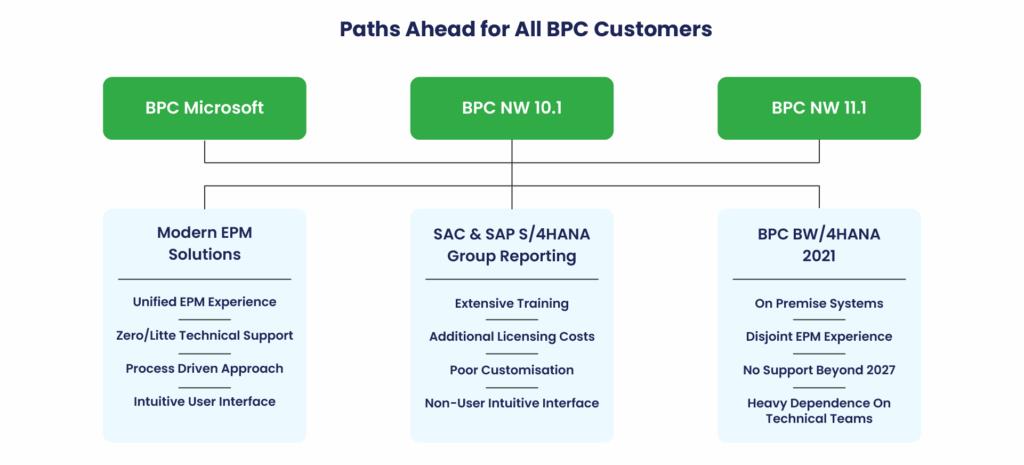Would you still buy a Walkman or subscribe to Spotify? Would you watch movies on DVD or subscribe to Netflix? Would you bet on floppy disks or invest in cloud platforms? It’s quite clear that the latter options are now preferable. Then why would you still rely on on-premise Enterprise Performance Management (EPM) solutions?
The world is moving on—so should you. Cloud-based EPM solutions have gained significant traction globally for their scalability, accessibility, cost-efficiency, automatic updates, data security, integration, advanced analytics, and real-time reporting. More importantly, their finance user-centric design is built to deliver business agility by empowering finance teams to take control of budgeting, consolidation, and reporting.
EPM software helps organizations manage and optimize key financial processes such as planning, budgeting, forecasting, consolidation, and reporting. However, traditional on-premise systems often fall short—they’re costly to maintain, slow to update, difficult to scale, and disconnected from the modern tools finance teams rely on. These limitations can lead to inefficiencies, bottlenecks, and missed opportunities in a fast-paced business environment.
Cloud-based EPM solutions solve these challenges by delivering agility, accessibility, and control. They offer scalability to support growth, secure remote access for distributed teams, automatic updates to meet evolving regulations, and a lower total cost of ownership. With robust data security, real-time reporting, and seamless integration with systems like ERP, CRM, and BI, these platforms are designed to empower finance teams—not rely on IT. The shift to the cloud isn’t just a technical upgrade—it’s a strategic move toward smarter, more efficient performance management.
For organizations currently using SAP BPC (Business Planning and Consolidation), a software application developed by SAP for planning, budgeting, forecasting, and financial consolidation, now is the time to start evaluating your path forward and consider transitioning to a modern, cloud-based EPM solution that meets today’s business needs.
What’s Next for SAP BPC Users
According to KPMG’s EPM survey, 72% of organizations with mature EPM journeys have experienced a 20% increase in revenue over the past three years. That kind of growth isn’t just impressive—it’s proof that modern, agile EPM tools can directly impact business performance. But if you’re still relying on SAP BPC, you risk heading in the opposite direction. Legacy challenges like a clunky user interface, high dependence on external consultants, limited scalability, and rising operational costs can quickly become roadblocks in a fast-evolving digital landscape and many more.
What’s the Price of Sticking With SAP BPC?
Learn More
So, what’s next for SAP BPC users? All existing BPC versions approaching end-of-maintenance are on-premise solutions—meaning they’re becoming increasingly outdated and unsupported. To stay competitive, organizations must consider migrating to SAP’s cloud-based alternatives: SAP S/4HANA Group Reporting for consolidation and SAP Analytics Cloud for planning. These solutions not only align with SAP’s long-term roadmap but also empower finance teams with real-time insights, streamlined processes, and seamless integration. The future of SAP EPM is in the cloud—and understanding your migration path is the first step toward unlocking the benefits.
Understanding SAP’s Proposed Paths for BPC Customers
Move to an On-premise Solution
SAP has announced end of support dates for the following versions of BPC:
- BPC Microsoft V10.1 (30th June 2026)
- BPC NetWeaver V10.1 (31st December 2027)
- BPC NetWeaver V11.1 (31st December 2024)
This means that the only version of BPC that continues to receive support is SAP BPC 2021 for BW/4HANA 2021, but its support is limited to a brief period.
For those BPC Microsoft and NetWeaver users who would like to shift to BPC 2021 for BW/4HANA 2021, the following should be kept in mind:
- BPC 2021 for BW/4HANA 2021 continues to remain on-premise
- Requires additional purchase of licenses for BPC and BW/4HANA
- Maintenance for this version ends on 31st December 2027 with a possible extension.
Since there is no significant change in the BPC 2021 version compared to Microsoft & NetWeaver versions, organizations will incur additional costs in buying new licenses but do not get any additional benefit from a functionality perspective. And not to forget, the heavy dependence on technical teams remains.
Even with slightly longer support, BPC 2021 is not a step forward, it’s a lateral move with extra cost. Organizations will spend time and money migrating to a platform that solves none of the core challenges and leaves them far from achieving a modern, finance-owned EPM future.
Move to a Cloud-based Solutions From SAP
Organizations that wish to remain with SAP while embracing cloud-based solutions must transition to SAP Analytics Cloud for planning and SAP S/4HANA Group Reporting for consolidation.

Although this may appear preferable to an on-premise solution, it may not be optimal. Let’s delve into the reasons why.
SAP Analytics Cloud
SAP Analytics Cloud is the cloud-native solution of SAP designed to help businesses make data-driven decisions. Out of the multiple benefits it provides to businesses, the ones relevant to finance users are:
- Data integration
- Predictive analytics
- Planning and budgeting
Therefore, SAP highly recommends that users transition from BPC to SAP Analytics Cloud for enterprise planning. Although SAP Analytics Cloud offers many advantages, it’s important to note that not all features available in BPC are available in SAP Analytics Cloud. While some functional overlap may exist, certain aspects that are typically found in BPC are not available in SAP Analytics Cloud. Here are some examples of these aspects:
- Workflow and process management: BPC offers workflow and process management features for budgeting and planning. It allows organizations to define, automate, and manage approval workflows, data submission processes, and audit trails. SAP Analytics Cloud has workflow capabilities, but they are generally more limited in scope than BPC.
- Detailed planning: BPC is suited for detailed financial planning, especially for organizations requiring line-item budgeting and forecasting. It offers extensive modelling and planning capabilities. SAP Analytics Cloud can manage planning and forecasting but only for high-level planning or rolling forecasts.
- Customization and scripting: BPC provides a high degree of customization through scripting and logic customization, allowing organizations to tailor the solution to their needs. SAP Analytics Cloud offers customization options but may be less flexible than BPC.
Apart from the above, here is what the current users of SAP Analytics Cloud are unhappy with:
- Extensive training: SAP Analytics Cloud has a very steep learning curve. It takes a long time for even experienced people to understand the solution completely.
- Exorbitant pricing: Many users feel that the price is too high compared to the benefits reaped from this solution.
- Complex interface: Both freshers and experienced users find navigating the solutions for their day-to-day tasks difficult.
- Slow response time: Many users have faced slow response/loading times when working with large amounts of data.
- Poor customization: Users have found that customization is very limited and painful.
For these reasons, while SAP Analytics Cloud may be a better choice than sticking with current versions of BPC, it still comes with the challenges that SAP products pose, namely, a system with a complex user interface that lacks agility.
SAP S/4HANA Group Reporting
While it’s true that SAP S/4HANA Group Reporting has all the features needed for close and consolidation, it’s important to keep the following obstacles in mind:
- High costs of migration will be incurred
- There will be long implementation cycles
- Your organization will be heavily dependent on technical teams /external consultants for maintenance and migration
In summary, the figure below highlights where each path leads from the end of support for BPC.

Regardless of the approach chosen, opting for the paths proposed by SAP leads to exorbitant costs and does not enhance business agility.
Staying competitive in the modern business landscape requires an agile mindset and willingness to embrace change. SAP BPC, built for past success, is too complex for current needs and does not deliver an efficient EPM experience. The high cost of ownership and heavy dependence on technical teams combined with a difficult-to-use interface makes it challenging for organizations to stay agile.
JustPerform For Your Migration
Upgrading to a unified, user-centric EPM platform is the first step toward overcoming the limitations of SAP BPC. JustPerform by insightsoftware is the leading alternative for SAP BPC customers ready to embrace modern EPM. With built-in BPC connectors, JustPerform automates and simplifies migration, eliminating manual work and reducing the risk of errors. Its intuitive interface, process-first design, and robust governance tools empower finance teams to take ownership of budgeting, consolidation, and reporting tasks—without relying heavily on IT or external consultants.
- Seamless SAP BPC Migration: Leverages built-in BPC connectors to automate data mapping, migration, and validation—minimizing disruption and reducing reliance on external consultants.
- User-Friendly and Finance-Focused: Designed for finance teams with an intuitive, self-service interface that simplifies planning, reporting, and consolidation without needing technical expertise.
- Process-First, Guided Workflows: Built-in process flows walk users through every step of EPM tasks, helping reduce errors, improve compliance, and boost efficiency.
- Cloud-Native Flexibility and Agility: Enables real-time collaboration, faster cycle times, and scalable deployment that adapts to changing business needs.
- Powerful Analytics with Built-In Governance: Delivers real-time insights with dashboards and what-if modeling, backed by audit trails, access controls, and reduced total cost of ownership.
The evidence is clear, prioritizing cloud-based EPM solutions is the way to go if you are an organization looking for superior business performance. With advanced analytics and real-time reporting, cloud solutions make budgeting, consolidation, and reporting more fluid and efficient in this evolving economy.
SAP BPC’s inability to keep its users agile makes it unsuitable for the modern marketplace. If you’re ready to begin your journey towards a more agile business model backed by powerful and user-friendly financial management solutions, then look no further than JustPerform.
Don’t Let Your Planning and Consolidation Strategy Become Obsolete: Discover a Seamless Migration Path from SAP BPC to JustPerform.
The post What Does the Future Hold for Organizations Using SAP BPC? appeared first on insightsoftware.
------------Read More
By: insightsoftware
Title: What Does the Future Hold for Organizations Using SAP BPC?
Sourced From: insightsoftware.com/blog/what-does-the-future-hold-for-organizations-using-sap-bpc/
Published Date: Tue, 08 Jul 2025 20:59:58 +0000
Did you miss our previous article...
https://trendinginbusiness.business/finance/7-anniversary-traditions-that-mean-nothing-but-couples-still-do-them
.png)





